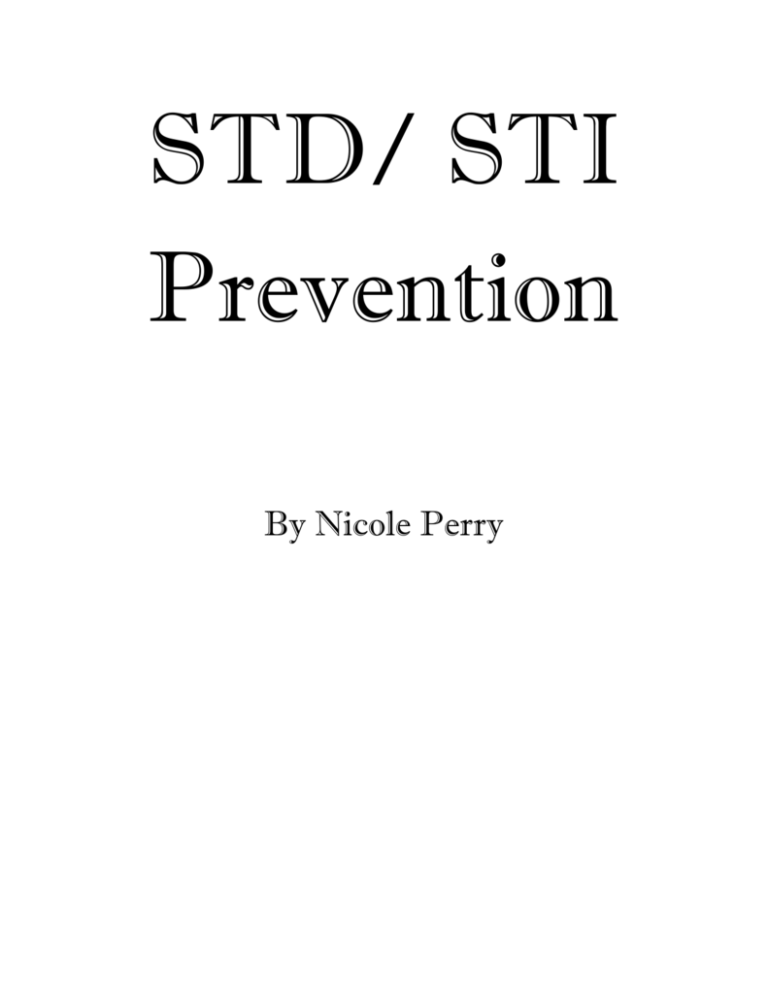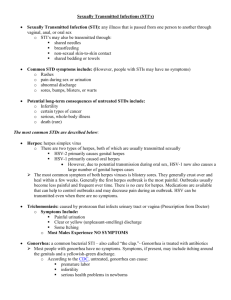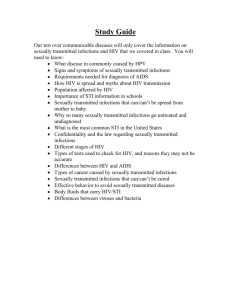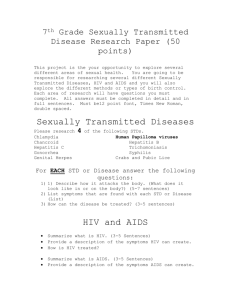STD
advertisement

STD/ STI Prevention By Nicole Perry Description Sexually transmitted diseases (STDs), or sexually transmitted infections (STIs), are generally acquired by sexual contact. The organisms or viruses that cause sexually transmitted diseases may pass from person to person in blood, semen, or vaginal and other bodily fluids. Some such infections can also be transmitted nonsexually, such as from mother to infant during pregnancy or childbirth, or through blood transfusions or shared needles. It's possible to contract sexually transmitted diseases from people who seem perfectly healthy — people who, in fact, aren't even aware of being infected. Many STDs cause no symptoms in some people, which is one of the reasons experts prefer the term "sexually transmitted infections" to "sexually transmitted diseases." This book manual has been created for the individual who believes he or she has been infected with a STD Common Symptoms and Alerts that you may have a STD Sexually transmitted infections (STIs) or Sexually transmitted diseases (STDs) have a range of signs and symptoms. That's why they may go unnoticed until complications occur or a partner is diagnosed. Signs and symptoms that might indicate an STI include: Sores or bumps on the genitals or in the oral or rectal area Painful or burning urination Discharge from the penis Vaginal discharge Unusual vaginal bleeding Sore, swollen lymph nodes, particularly in the groin but sometimes more widespread Lower abdominal pain Rash over the trunk, hands or feet Signs and symptoms may appear a few days to years after exposure, depending on the organism. They may resolve in a few weeks, even without treatment, but progression with later complications — or recurrence — sometimes occurs. Data and statistics STD/STI in the U.S per year THE FACTS: One in two sexually active young people will get an STD by the age of 25. Most young people with STDs don’t even know they have them. Getting tested is the only way to know for sure. STDs are really common -- every year there are more than 19 million new cases in the U.S. Left untreated, some STDs can cause infertility or increase your risk of getting cancer More than 50 percent of sexually active people will get HPV at some point during their lives. Specific STI/STDs and their related symptoms Acquired Immune Deficiency Syndrome (AIDS) AIDS is caused by the human immunodeficiency virus (HIV), a virus that destroys the body's ability to fight off infection. People who have AIDS are very susceptible to many lifethreatening diseases and to certain forms of cancer. Transmission of the virus occurs during sexual activity or by the sharing of needles used to inject intravenous drugs Chlamydial Infections Chlamydial infections, the most common of all STDs, can affect both males and females. Infections may cause an abnormal genital discharge and burning with urination. In females, untreated chlamydial infection may lead to pelvic inflammatory disease (PID). Human Papillomaviruses (HPVs) Human papillomavirus (HPV) is a common sexually transmitted disease that can cause genital warts. These warts can occur on the inside or outside areas of the genitals and may spread to the surrounding skin or to a sexual partner. Because HPV infection does not always cause warts, the infection may go undetected. Women with HPV infection have an increased risk of developing cervical cancer. Regular Pap smears can detect HPV infection as well as abnormal cervical cells. Gonorrhea Gonorrhea causes a discharge from the vagina or penis and painful or difficult urination. The most common and serious complications occur in females, which include pelvic inflammatory disease, ectopic (tubal) pregnancy and infertility. Genital Herpes Genital herpes infections are caused by the herpes simplex virus (HSV) Symptoms may include painful blisters or open sores in the genital area, which may be preceded by a tingling or burning sensation in the legs, buttocks, or genital region. The herpes sores usually disappear within a few weeks, but the virus remains in the body and the lesions may recur from time to time. Syphilis The cause of syphilis is a bacterium called Treponema pallidum. The most common route of transmission is through contact with an infected person's sore during sexual activity. Genital Warts Genital warts are caused by a virus related to the virus that causes common skin warts. Usually, genital warts first appear as small, hard, painless bumps in the vaginal area, on the penis, or around the anus. Other diseases that may be sexually transmitted include the following: The initial symptom of syphilis is a painless open sore that usually appears on the penis or around or in the vagina. If untreated, syphilis may go on to more advanced stages, including a transient rash and, eventually, serious involvement of the heart and central nervous system. Bacterial vaginosis. Pubic lice. Scabies. Trichomoniasis. Vaginal yeast infections. Populations at risk Gender- Women suffer more frequent and more serious STD complications than men do. Among the most serious STD complications are pelvic inflammatory disease, ectopic pregnancy (pregnancy outside of the uterus), infertility, and chronic pelvic pain Age disparities - Compared to older adults, sexually active adolescents ages 15 to 19 and young adults ages 20 to 24 are at higher risk for getting STDs. Racial and ethnic disparities - Certain racial and ethnic groups (mainly African American, Hispanic, and American Indian/Alaska Native populations) have high rates of STDs, compared with rates for whites. Access to health care - Access to high-quality health care is essential for early detection, treatment, and behavior-change counseling for STDs. Groups with the highest rates of STDs are often the same groups for whom access to or use of health services is most limited. Substance abuse - Many studies document the association of substance abuse with STDs. The introduction of new illicit substances into communities often can alter sexual behavior drastically in high-risk sexual networks, leading to the epidemic spread of STD Sexuality and “secrecy” - Perhaps the most important social factors contributing to the spread of STDs in the United States are the stigma associated with STDs and the general discomfort of discussing intimate aspects of life, especially those related to sex. These social factors separate the United States from industrialized countries with low rates of STDs. Risk factors Having unprotected sex. Vaginal or anal penetration by an infected partner who is not wearing a latex condom transmits some diseases with particular efficiency. Without a condom, a man who has gonorrhea has a 70 to 80 percent chance of infecting his female partner in a single act of vaginal intercourse. Improper or inconsistent use of condoms can also increase your risk. Oral sex is less risky but may still transmit infection without a latex condom or dental dam. Dental dams — thin, square pieces of rubber made with latex or silicone — prevent skin-to-skin contact. Having sexual contact with multiple partners. The more people you have sexual contact with, the greater your overall exposure risks. This is true for concurrent partners as well as monogamous consecutive relationships. Having a history of STIs. Being infected with one STI makes it much easier for another STI to take hold. If you're infected with herpes, syphilis, gonorrhea or chlamydia and you have unprotected sex with an HIV-positive partner, you're more likely to contract HIV. Also, it's possible to be reinfected by the same infected partner if he or she isn't also treated. Abusing alcohol or using recreational drugs. Substance abuse can inhibit your judgment, making you more willing to participate in risky behaviors. Injecting drugs. Needle sharing spreads many serious infections, including HIV, hepatitis B and hepatitis C. If you acquire HIV by injecting drugs, you can transmit it sexually. Being an adolescent female. In adolescent girls, the immature cervix is made up of constantly changing cells. These unstable cells make the adolescent female cervix more vulnerable to certain sexually transmitted organisms. Legal rights and responsibilities Physicians, hospitals, and laboratories are required by law to submit reports of communicable disease and other situations that pose a threat to the public health. Nebraska, as in most states, syphilis; gonorrhea; HIV/AIDS; and chlamydia are reported to the appropriate health department. If you're nervous about talking to your partners, here are a few tips to help you gain confidence: Try role-playing with a trusted friend or in front of a mirror. Practice saying the words out loud. Choose a neutral setting during a time when you won't be distracted or interrupted. Be natural. Speak with confidence. You are not lecturing or confessing. You're sharing personal information. Remain calm. If you're upset, a partner might think it's worse than it is. Remember your delivery and body language becomes your message, too. Expect your partner to be accepting and supportive. People usually act as you expect them to. While some people may overreact, some won't bat an eye. However they react, it’s out of your control. Try not to be surprised and give them time to think about what you're telling them and asking them People you may want to tell if you are positive SEX PARTNERS You may be thinking about telling people you had unprotected sex with before you knew you were positive. Telling sex partners after the fact is not easy, but, it's a law in most states that those who are HIV positive must tell their partners before they have sex, so it’s something that must be done. You might want to ask them if they're already positive. If they're not, you might be able to help and support them through the process of getting tested. FAMILY AND CLOSE FRIENDS Some people don't tell their friends and families because they don't want them to worry or they're afraid of being rejected. By not telling, you could be cheating yourself out of an important source of love and support. PEOPLE YOU WORK WITH The main thing to know about HIV and the workplace is that you're entitled to protections under federal law. You can't lose your job just because you have HIV. It's often good to tell your supervisor, since you might need time off for doctor's appointments or other health reasons Prevention Abstain. The most effective way to avoid STIs is to abstain from sex. Stay with 1 uninfected partner. Another reliable way of avoiding STIs is to stay in a long-term mutually monogamous relationship with a partner who isn't infected. Get vaccinated. Getting vaccinated early, before sexual exposure, is also effective in preventing certain types of STIs. Vaccines are available to prevent two viral STIs that can cause cancer — human papillomavirus (HPV), hepatitis A and hepatitis B. The Centers for Disease Control and Prevention (CDC) recommends the HPV vaccine for girls and boys ages 11 and 12. If not fully vaccinated at ages 11 and 12, the CDC recommends that girls and women through age 26 and boys and men through age 26 receive the vaccine. The hepatitis B vaccine is usually given to newborns. Use condoms and dental dams consistently and correctly. Use a new latex condom or dental dam for each sex act, whether oral, vaginal or anal. Never use an oil-based lubricant, such as petroleum jelly, with a latex condom or dental dam. Keep in mind that while condoms reduce your risk of exposure to most STIs, they provide a lesser degree of protection for STIs involving exposed genital sores, such as human papillomavirus (HPV) or herpes. Also, nonbarrier forms of contraception, such as oral contraceptives or intrauterine devices, don't protect against STIs. Don't drink alcohol excessively or use drugs. If you're under the influence, you're more likely to take sexual risks. Avoid anonymous, casual sex. Don't look for sex partners online or in bars or other pickup places. Not knowing your sex partner well increases your risk of possible exposure to an STI. Treatments Antibiotics Antibiotics, often in a single dose, can cure many sexually transmitted bacterial and parasitic infections, including gonorrhea, syphilis, chlamydia and trichomoniasis. Typically, you'll be treated for gonorrhea and chlamydia at the same time because the two infections often appear together. Once you start antibiotic treatment, it's crucial to follow through. If you don't think you'll be able to take medication as prescribed, tell your doctor. A shorter, simpler treatment regimen may be available. In addition, it's important to abstain from sex until you've completed treatment and any sores have healed. Antiviral drugs Can be used for a few different diseases such as herpes Support services and resources It’s easier to talk to your partners about STD/HIV after you’ve come to terms with it yourself. Give yourself time to work through it. If you are well informed and know the facts about STDs or HIV, you’ll be more confident and at-ease when discussing the situation. You can always call 1-800-CDC-INFO (1-800-232-4636) to talk to someone personally and to get brochures and information to give your partners. Other numbers National AIDS Hotline: (800) 342-AIDS Herpes Resource Center: (919) 361-2120 National Planned Parenthood Hotline: (800) 230-7526 TEEN Line (provides peer-to-peer counseling for teens): (800) 443-8336 Toll-free, 24 hours National STD Hotline: (800) 227-8922 What Can/should be done? If you think you have a STD/STI… Get Tested The only way to know for sure if you have a STD or STI is to get tested. If you think you have one contact your local physician or other health care provider The key to any disease or infection is early diagnosis and treatment References Statistics of sexually transmitted infections . (n.d.). Retrieved from http://www.ashasexualhealth.org/std-sti/std-statistics.html Std resources . (n.d.). Retrieved from http://www.thestdproject.com/stdresources/std-help-hotlines/ Center of disease control stds. (2013, December 10). Retrieved from http://www.cdc.gov/std/ Sexually transmitted diseases . (2013, November,26). Retrieved from http://www.nlm.nih.gov/medlineplus/sexuallytransmitteddiseases.html Sexually transmitted diseases . (2012, November 14). Retrieved from http://www.nlm.nih.gov/medlineplus/sexuallytransmitteddiseases.html






